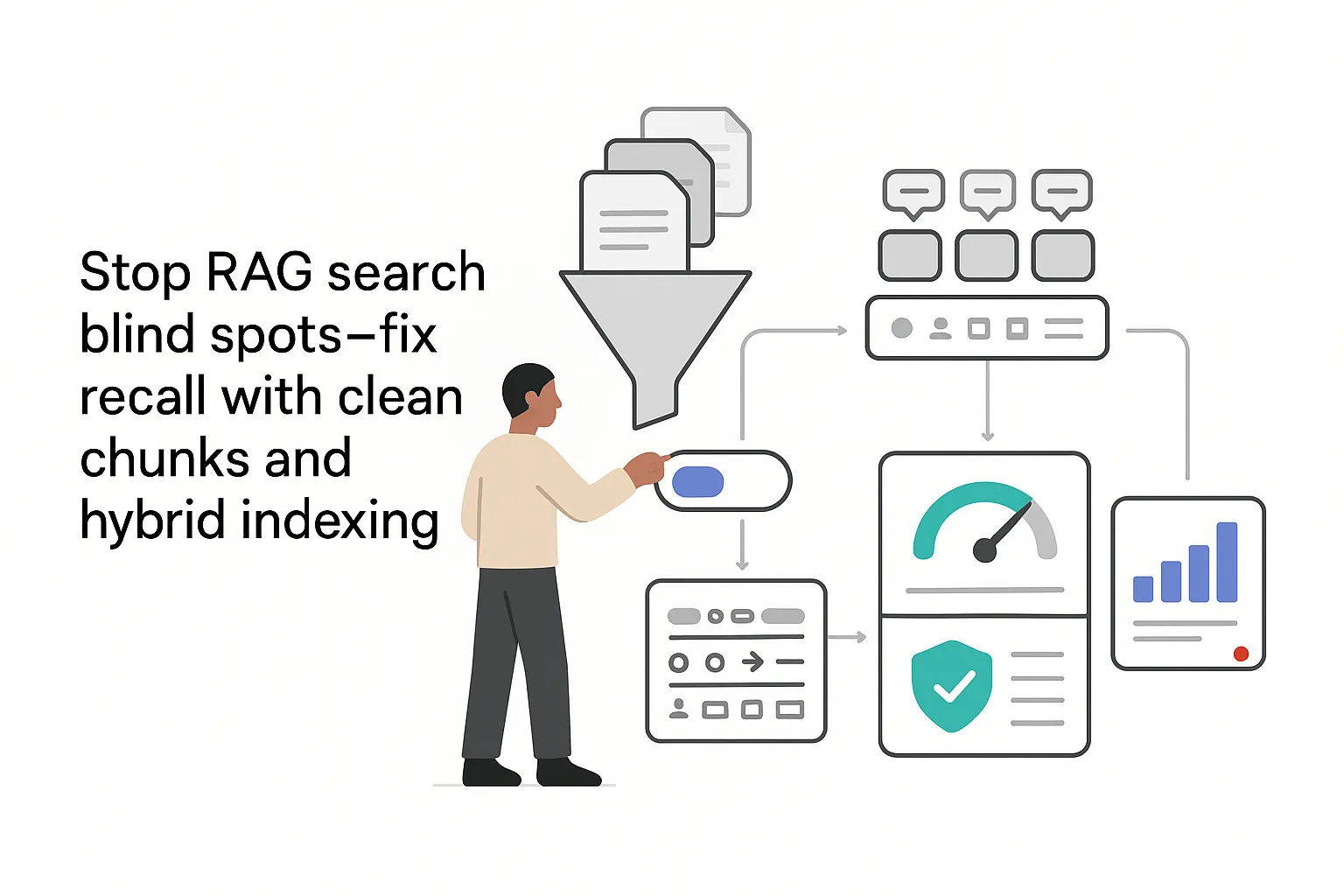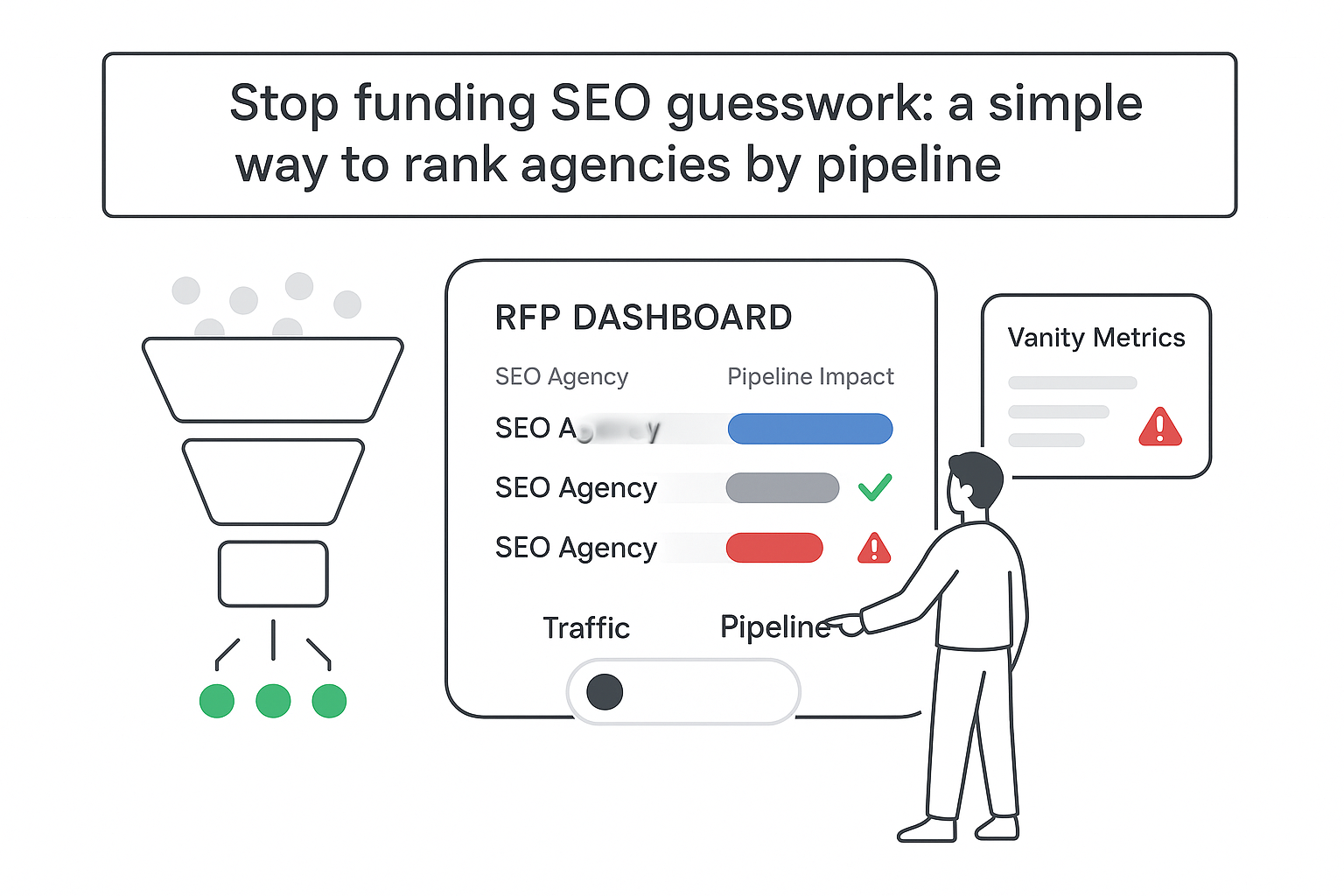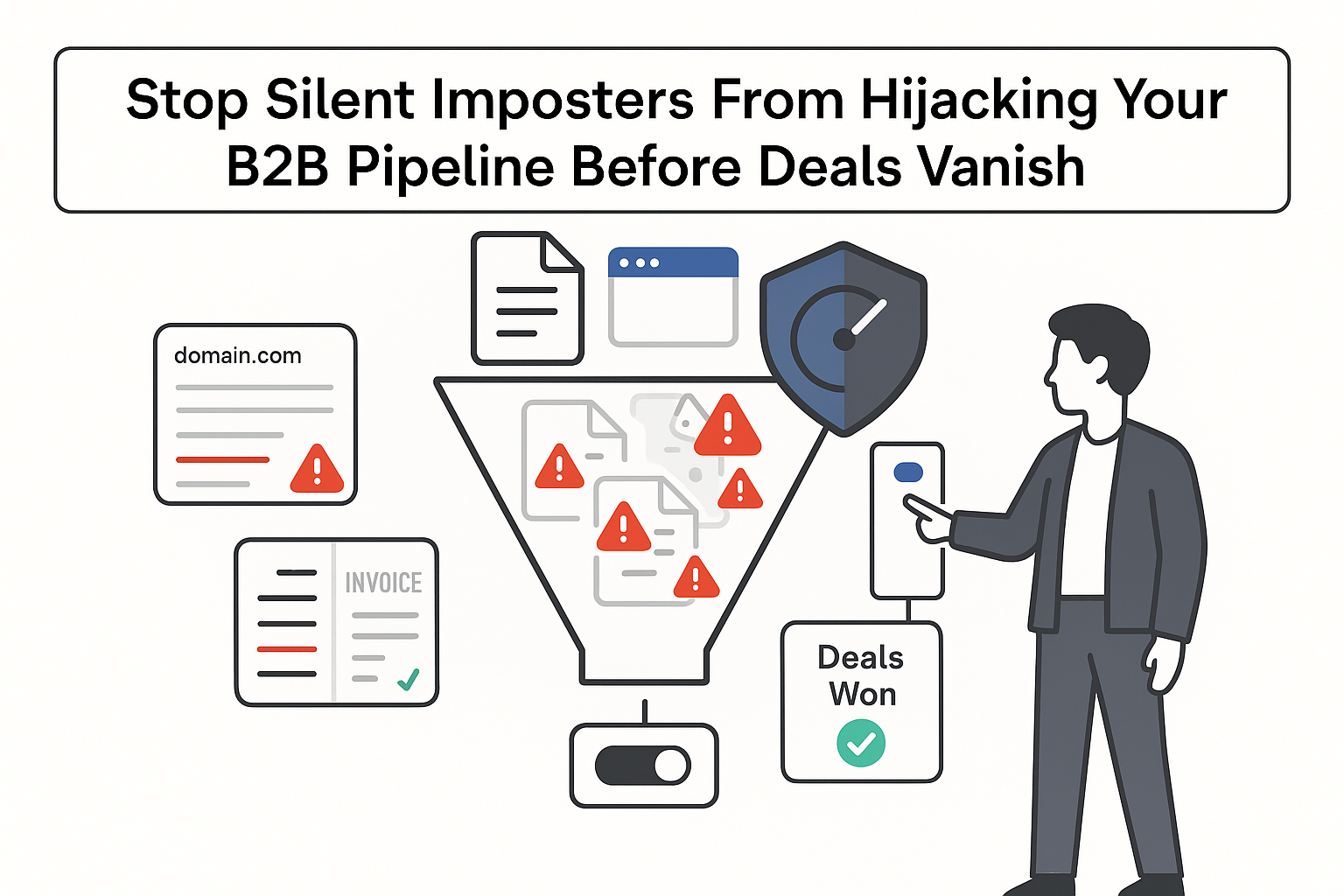I already paid for the traffic and wrote the content. Now I make it answer-ready. I treat my site as a living knowledge system that feeds both on-site assistants and external AI answer engines. When I structure content for retrieval, questions get answered faster, buyers move with less friction, and my team answers fewer one-off emails. That is the point here.
AI search hub content architecture
I define an AI search hub content architecture as an AI-native content layer that turns a site and knowledge assets into a retrieval-ready hub. I put outcomes first: I aim to increase qualified inbound, reduce CAC, and shorten sales cycles by making answers fast and trustworthy - then I validate those outcomes with measurement.
For busy B2B leaders, I treat this like a focused operating model for content. Pages and docs are broken into clean, reusable chunks, tagged with context, indexed across lexical and vector stores, and surfaced with citations. Think of it as information architecture for AI portals, but measurable and tied to pipeline.
Proof points I track (with simple definitions)
- Retrieval recall@5 and nDCG@10: share and quality of relevant results in the top set
- Answer accuracy and faithfulness: factual alignment with cited sources
- Citation rate and query coverage: percent of answers with sources and percent of queries that get an answer
- Time to first answer: latency from query to first token
- Assisted pipeline and MQL→SQL conversion: influenced opportunities and stage progression tied to answerable content
Quick wins to unlock in 30 to 60 days
- Refactor the top 20 revenue-driving pages into RAG-ready units
- Add schema and metadata to expose structure
- Deploy a hybrid index that blends keyword and vector retrieval
- Launch a simple on-site assistant that always cites sources
Notes on what already exists
- One popular vendor guide explains RAG mechanics well, but it is tied to a single stack.
- Another widely shared manual breaks down platform behaviors nicely, yet it underweights content modeling.
- I wrote this to bridge both with a clear content-first architecture you can use regardless of stack.
If you like mental pictures, imagine a full flow: content sources feed parsing and chunking, embeddings plus metadata land in a hybrid index, a retriever and reranker pick the best passages, an LLM writes a cited answer, and the UI plus analytics closes the loop.
RAG-ready content architecture
RAG is not magic. It is a repeatable pipeline that turns messy pages into trustworthy answers. For B2B service companies, it maps cleanly to content you already have: service pages, case studies, playbooks, proposals, webinars, SOPs, and more. It only works as well as the underlying content - thin, outdated, or salesy pages limit recall and answer quality - so I keep content freshness and scope tight.
A practical pattern I use
- Ingest: pull from your CMS, docs, and knowledge base with versioning
- Parse: extract text, headings, tables, and media captions
- Chunk: 200-400 token atomic chunks, cut on headings and sections; keep 15-25% overlap to preserve context across boundaries; assign hierarchical IDs like doc.section.chunk
- Embed: build vectors per chunk, and also a document-level vector
- Index: hybrid setup with keyword fields and vector fields
- Retrieve: run BM25 and vector search in parallel
- Rerank: pass the top ~50 to a cross-encoder for sharper ordering
- Synthesize: answer plus highlights plus citations including URL, anchor text, and timestamp
- Cite and log: always return sources and log which chunks were used
- Evaluate: measure recall@k, nDCG, and faithfulness; use LLM-as-judge for scale, then verify with human spot checks; adjust chunking and query rewrite rules based on findings
Governance guardrails I keep in place
- Access controls at document and field level
- PII redaction before embedding
- Audit logs for every retrieval and generation event
Stack notes
I keep this vendor-neutral. It works across cloud search services, open-source search engines, and popular vector databases. I abstract embeddings so I can swap models later, and I keep prompts and reranking logic portable.
Content modeling for AI knowledge hubs
If the content model is loose, retrieval gets loose too. I make content searchable by design with clear types, shared fields, and reusable relationships. This is where a knowledge graph-driven content architecture pays off, because relationships improve recall and sharpen answers.
Core content types for B2B services
- Service
- Use Case
- Industry Page
- Case Study
- Solution Brief
- FAQ
- How To
- Webinar Transcript
- Whitepaper
- SOP
- Pricing Guide
Required shared fields
- title
- abstract
- ideal_customer_profile or pain
- buyer_stage
- industry
- service_line
- geography
- persona
- compliance_tag such as SOC2 or HIPAA
- published_at and updated_at
- canonical_url
- source_of_truth flag
- access_level
- doc_owner
Retrieval fields that do the heavy lifting
- searchable_text cleaned of boilerplate
- semantic_sections array of sections with headings and scopes
- keywords_synonyms array
- entities array of organizations, people, products, tech terms
- qa_pairs harvested from headings and summaries
- embeddings at both section and doc level
Cross-link rules
Each type links to at least two others. Example: Service links to two Case Studies and one How To. Case Study links back to Service and Industry Page. These edges form a content graph that explains how ideas connect.
A JSON-like example
{
"type": "Service",
"title": "Managed Cloud Security",
"abstract": "24x7 monitoring and incident response for regulated industries.",
"ideal_customer_profile": ["Mid-market healthcare", "Fintech start-ups"],
"buyer_stage": "Consideration",
"industry": ["Healthcare", "Financial Services"],
"service_line": ["Security Operations"],
"geography": ["US", "UK"],
"persona": ["CTO", "Head of IT"],
"compliance_tag": ["SOC2", "HIPAA"],
"published_at": "2024-06-15",
"updated_at": "2025-01-05",
"canonical_url": "https://example.com/services/managed-cloud-security",
"source_of_truth": true,
"access_level": "public",
"doc_owner": "security@company.com",
"searchable_text": "...clean body text...",
"semantic_sections": [
{ "id": "svc.1.1", "heading": "What is included", "text": "..." },
{ "id": "svc.1.2", "heading": "Who it helps", "text": "..." }
],
"qa_pairs": [
{ "q": "Do you support HIPAA?", "a": "Yes, with BAAs available." }
],
"embeddings": {
"doc_vector": [/* float64[] */],
"section_vectors": {"svc.1.1": [/*...*/], "svc.1.2": [/*...*/]}
},
"links": {
"case_studies": [
"https://example.com/case-studies/hipaa-readiness"
],
"how_tos": [
"https://example.com/how-to/security-runbooks"
]
}
}You might wonder if you need a new CMS for this. I usually do not. Most teams add a thin modeling layer and a tagging workflow, then hydrate an index from those fields. I keep it pragmatic.
Content taxonomy for AI discovery
I treat taxonomy as the subtle glue that powers both vector recall and symbolic filters. I build a controlled vocabulary and keep it fresh.
Core axes
- Industry and subindustry
- Service and sub-service
- Buyer stage
- Persona
- Problem and outcome
- Geography
- Compliance
- Tech stack
How I author and maintain it
- Use a SKOS-like list with preferred labels, alternate labels, and disallowed terms
- Maintain expansion lists for query rewrite (e.g., SOC2 Type II, SOC 2, Service Organization Control 2)
- Run a change board monthly; update terms based on pipeline analysis and new services
Expose your taxonomy
- Mark up pages with schema.org types like Service, FAQPage, HowTo, and CaseStudy
- Use BreadcrumbList for hierarchy
- Publish JSON-LD so crawlers and AI engines can read the structure without guesswork
Mapping example
- Phrase: SOC2 audit readiness
- Mapped tags: Compliance SOC2, Buyer Stage Consideration, Persona CTO, Service Security Operations
Vector search content structuring
This is where modeling becomes an index that retrieves well. Most teams get big gains from a hybrid index and a thoughtful embedding plan.
Embedding strategy
- Start with strong general models such as bge and e5; if a vendor model is required, use a large text embedding model and keep the interface abstract so you can switch later
- Store multiple vectors per chunk: title, body, and entities each get a vector to match short labels and longer passages
- Keep a document-level vector to rescue broad questions
Index design
- Hybrid index that supports BM25 and a vector index such as HNSW or IVF-PQ
- Store vectors at section and doc level; section vectors answer precise questions, doc vectors keep you in the candidate pool
- Consider late interaction methods such as ColBERT-like scoring or cross-encoders on the top ~50 to tighten precision on long docs
Ingestion rules
- Normalize whitespace, preserve headings, strip boilerplate and cookie banners
- Keep internal links and citations; they can be used in synthesis and to score authority
- Track versions and vector_version so you know which model created each embedding
Multi-tenancy and roles
- Namespace by client or role where needed; keep ACLs in the index so restricted content never leaves the gate
Evaluation that drives decisions
- Build a test set with 50 to 200 questions tied to your ICP and buyer stages
- Track recall@5, MRR (mean reciprocal rank), nDCG, and latency P95 (95th percentile)
- Run ablations on chunk size, overlap, and model choice; keep what moves recall without forcing up latency
A tiny before and after
- Before: keyword-only index returns a single generic page, no citation snippets
- After: hybrid retrieval returns two scoped sections and a matching FAQ pair, reranked to the top with clear citations; the assistant answers in one turn
Semantic search content strategy
A hybrid pipeline is the engine behind relevance and recall. It starts by understanding the query, then fans out across retrieval modes, then narrows back down to the best grounded answer.
A clean flow I implement
- Query understanding parses intent, entities, and buyer stage; it also checks for persona and compliance hints
- Query fan-out issues parallel lexical and vector runs with filters from your taxonomy
- Retrieval pulls from your site, document stores, CRM notes, and your knowledge base
- Aggregation and deduplication mix the results, remove duplicates, and ensure freshness
- Cross-encoder reranking reshuffles the top pool based on context
- LLM synthesis writes the answer and attaches citations
Query rewrite tactics that matter
- Synonym expansion from your taxonomy
- Unit normalization and abbreviation expansion
- Persona and stage biasing so a CFO-style query does not get a developer-style answer
Platform notes
Major search engines now blend classic ranking with AI answers. To show up, I write pages with concise, answerable sections, place short definitions near the top, add schema markup, and keep HTML clean. I avoid render-blocked JavaScript, double-check canonical signals, and keep robots directives correct. It is simple housekeeping, yet it decides if your content even makes the candidate pool.
Tracking the outside world
- Watch for SERP features, citations in AI answer modules, and mentions from popular answer engines
- Tie those appearances back to pages and sections in your index
- If inclusion drops, review chunking and taxonomy coverage; missing entities often cause it
I keep the strategy grounded in information architecture for AI portals so the assistant can navigate by type, intent, and relationship, not just by words on a page.
Metadata strategy for AI search
Tagging is the fuel for semantic retrieval and governance. Skipping it saves time today and costs results tomorrow.
Required metadata fields
- canonical_url
- doc_type
- persona
- industry
- service_line
- geo
- buyer_stage
- compliance
- freshness score and updated_at
- source_of_truth boolean
- content_quality_score
- ACL
- vector_version and schema_version
- confidence score (model-estimated and/or human-labeled)
Content tagging for semantic retrieval
- Blend rules-based tagging with ML-assisted suggestions
- Run a human approval workflow for high-impact pages
- Keep tag density between 3 and 7 primary tags per doc
- Standardize naming and cases; avoid near-duplicates that split recall
Technical signals to set
- x-robots-tag for index or noindex at the right levels
- hreflang or geo where relevant
- OpenGraph and Twitter tags for sharing previews
- JSON-LD for Service, FAQPage, HowTo, and CaseStudy types
Common inclusion issues and fixes
- Robots disallow or noindex set by mistake: fix directives at the template level
- Canonicalized away: ensure self-referencing canonicals on canonical pages
- JS-gated content that never renders server side: ship meaningful HTML without waiting for the client
- Duplicated language or geo variants with weak signals: add hreflang and clear regional labels
- Poor internal linking: link by type and intent (e.g., Services to FAQs and Case Studies)
- Thin content or buried answers: lift definitions and key claims into short, scoped paragraphs
How to get started
I do not need a big-bang rebuild. I run a tight pilot that proves recall and conversion lift, then expand with confidence.
Week 0 to 2
- Inventory the top 50 to 100 assets tied to revenue
- Draft the taxonomy and choose KPI targets such as recall@5 and nDCG@10
- Set up an evaluation harness with gold questions per page and a small LLM-as-judge workflow plus human spot checks
Week 3 to 4
- Finish content modeling; create JSON templates for each type
- Write tagging guidelines and examples
- Pilot chunking on 10 to 20 assets; test overlap and boundary rules
Week 5 to 8
- Build a hybrid index; a search engine plus a vector store is enough
- Implement query rewrite and a cross-encoder reranker
- Wire a simple synthesis layer that always cites specific chunk IDs and URLs
Week 9 to 12
- Expand ingestion to the next 100 assets
- Run retrieval evaluations weekly; fix low-recall pages first
- Target an on-site assistant that can answer and cite within 1 to 2 seconds for common questions
- Instrument dashboards that show retrieval metrics and assisted pipeline attribution
Ownership model
- Content operations owner keeps types, fields, and workflow in shape
- Data or ML integrator manages embeddings, indexes, evaluation, and pipelines
- SEO lead owns taxonomy, schema markup, and external search visibility
- Compliance reviewer enforces PII redaction and access rules
Budget notes
- Start with cloud tools already in place; keep embedding and reranker interfaces abstract so you can switch models later
- Use open components where it makes sense; clear docs and logs reduce lock-in risk
Risk controls
- PII redaction runs before embedding and again before synthesis
- ACL checks happen at retrieval time and in the app layer
- Run offline evaluation before each production release and keep a rollback plan
A simple way to start small and win
Pick one service line. Convert five pages, two case studies, and one FAQ into clean chunks with tags. Index them, run the hybrid pipeline, and compare recall@5, time to first answer, and MQL→SQL conversion against the old flow. Once you see lift, repeat the pattern across the rest of the site. As you scale, expand the knowledge graph-driven content architecture so new pages inherit the context and your assistant grows wiser without extra work.
Final thought
AI search is not only about models. It is about structure, clarity, and trust. When content is chunked, tagged, and linked with care, every system in the stack performs better. Buyers feel it, your team feels it, and your pipeline shows it.







.svg)